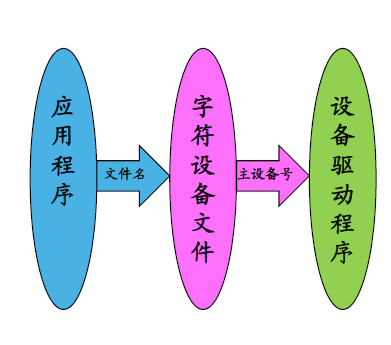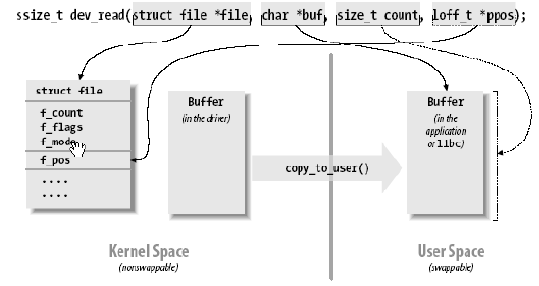1. Linux字符设备是一种按字节来访问的设备,字符驱动则负责驱动字符设备,这样的驱动通常实现open、close、read和write系统调用。例如:串口、Led、按键等。
2. 通过字符设备文件(/dev/xxx),应用程序可以使用相应的字符设备驱动来控制字符设备

3. 创建字符设备文件的方法一般有两种
(1)使用命令mknod : mknod /dev/文件名 c 主设备号 次设备号 (查看主设备号:cat /proc/devices)
(2)使用函数创建:mknod()
int mknod(const char *pathname, mode_t mode, dev_t dev);
4. 文件系统与字符设备驱动程序之间的关系

(1)在Linux系统中,每一个打开的文件,在内核中都会关联一个struct file结构,它是由内核在打开文件时创建,在文件关闭后释放。
struct file结构中的重要成员
* struct file_operations* f_op; //文件操作函数集
* loff_t f_pos; //文件读写指针
(2)每一个存在于文件系统中的文件都会关联一个inode结构,该结构主要用来记录文件物理上的信息。因此,它和代表打开文件的file结构是不同的,一个文件没有被打开时不会关联file结构,但是会关联一个inode结构(存于磁盘,操作文件时在内存中建立相应的映射结构)
注:inode用于存储文件的元信息(除了文件名的所有信息),中文译名索引节点
(3)从上图可知,系统实质上是把字符设备的注册表看成了文件。其中chrdevs[]在内核的定义如下
static struct char_device_struct { struct char_device_struct *next; unsigned int major; unsigned int baseminor; int minorct; char name[64]; struct cdev *cdev; /* will die */ } *chrdevs[CHRDEV_MAJOR_HASH_SIZE];
5. 在任何一种驱动模型中,设备都会用内核中的一种结构来描述。字符设备在内核中使用struct cdev来描述
struct cdev { struct kobject kobj; struct module *owner; const struct file_operations *ops; //设备操作函数集 struct list_head list; dev_t dev; //设备号 unsigned int count; //设备数 };
6. Linux内核中使用dev_t类型来定义设备号,dev_t其实质为32位unsigned int类型,其中高12位为主设备号,低20位为次设备号。
(1)MKDEV(主设备号,次设备号)
(2)MAJOR(dev_t dev)
(3)MINOR(dev_t dev)
注:字符设备文件与字符设备驱动是通过主设备号建立对应关系;驱动程序用次设备号来区分同类型的设备
7. 设备号的申请与注销
(1)静态申请:开发者自己选择一个数字作为主设备号,通过函数 register_chardev_region 向内核申请
(2)动态分配:使用 alloc_chrdev_region 由内核分配一个可用的主设备号(推荐使用)
(3)不论使用何种方法分配设备号,都应该在驱动退出时,使用 unregister_chrdev_region 函数释放这些设备
8. 操作函数集:struct file_operations是一个函数指针的集合,定义能在设备上进行的操作。
9. 字符设备描述结构的分配、注册与注销
(1)cdev变量的定义可以采用静态和动态两种方法
* 静态分配:struct cdev mdev;
* 动态分配:struct cdev* pdev = cdev_alloc();(可以通过命令:cat /proc/devices查看主设备号)
(2)cdev变量的初始化使用cdev_init()函数来完成
void cdev_init(struct cdev *cdev, const struct file_operations *fops)
cdev: 待初始化的cdev结构
fops: 设备对应的操作函数集
(3)字符设备的注册使用cdev_add()函数来完成
(4)字符设备的注销使用cdev_del()函数来完成
10. 设计Linux字符设备驱动程序的主要工作:
(1)根据外部设备的特点,实现file_operations结构所需要的函数
(2)调用函数cdev_alloc()函数向系统动态申请一个cdev结构实例
(3)调用函数cdev_init()初始化cdev实例,并建立cdev实例与file_operations实例之间的连接
(4)调用函数alloc_chrdev_region()向系统申请一个设备号
(5)调用函数cdev_add()向系统添加一个设备
(6)调用函数cdev_del()从系统删除一个cdev结构实例
注:如果把驱动程序制作成一个内核模块,上述的第(2)、(3)、(4)、(5)步应在模块的初始化函数中实现,而第(6)步应在模块的卸载函数中实现
11. 设备操作:struct file_operations
struct file_operations { struct module *owner; loff_t (*llseek) (struct file *, loff_t, int); ssize_t (*read) (struct file *, char __user *, size_t, loff_t *); ssize_t (*write) (struct file *, const char __user *, size_t, loff_t *); ssize_t (*aio_read) (struct kiocb *, const struct iovec *, unsigned long, loff_t); ssize_t (*aio_write) (struct kiocb *, const struct iovec *, unsigned long, loff_t); int (*readdir) (struct file *, void *, filldir_t); unsigned int (*poll) (struct file *, struct poll_table_struct *); int (*ioctl) (struct inode *, struct file *, unsigned int, unsigned long); long (*unlocked_ioctl) (struct file *, unsigned int, unsigned long); long (*compat_ioctl) (struct file *, unsigned int, unsigned long); int (*mmap) (struct file *, struct vm_area_struct *); int (*open) (struct inode *, struct file *); int (*flush) (struct file *, fl_owner_t id); int (*release) (struct inode *, struct file *); int (*fsync) (struct file *, struct dentry *, int datasync); int (*aio_fsync) (struct kiocb *, int datasync); int (*fasync) (int, struct file *, int); int (*lock) (struct file *, int, struct file_lock *); ssize_t (*sendpage) (struct file *, struct page *, int, size_t, loff_t *, int); unsigned long (*get_unmapped_area)(struct file *, unsigned long, unsigned long, unsigned long, unsigned long); int (*check_flags)(int); int (*flock) (struct file *, int, struct file_lock *); ssize_t (*splice_write)(struct pipe_inode_info *, struct file *, loff_t *, size_t, unsigned int); ssize_t (*splice_read)(struct file *, loff_t *, struct pipe_inode_info *, size_t, unsigned int); int (*setlease)(struct file *, long, struct file_lock **); };
(1)open: int (*open) (struct inode *, struct file *);(打开设备,响应open系统调用)
open方法是驱动程序用来为以后的操作完成初始化准备工作的。在大部分驱动程序红,open主要完成以下工作:
* 标明次设备号
* 启动设备
(2)release: int (*release) (struct inode *, struct file *);(关闭设备,响应close系统调用)
(3)llseek: loff_t (*llseek) (struct file *, loff_t, int);(重定位读写指针,响应lseek系统调用)
(4)read:ssize_t (*read) (struct file *, char __user *, size_t, loff_t *);(从设备读取数据,响应read系统调用)
① read设备方法通常完成两件事情
* 从设备中读取数据(属于硬件访问类操作)
* 将读取到的数据返回给应用程序
② ssize_t (*read) (struct file *filp, char __user *buff, size_t count, loff_t *offp)
filp:与字符设备文件关联的file结构,由内核创建
buff:从设备文件读取到的数据,需要保存到的位置。由read系统调用提供该参数
count:请求传输的数据量,由read系统调用提供该参数
offp:文件的读写位置,由内核从file结构中取出后,传递进来
③ buff参数是来源于用户空间的指针,这类指针都不能被内核代码直接引用,必须使用专门的函数
int copy_from_user(void *to, const void __user *from, int n) int copy_to_user(void __user *to, const void *from, int n)

(5)write:ssize_t (*write) (struct file *, const char __user *, size_t, loff_t *);(向设备写入数据,响应write系统调用)
① write设备方法通常完成2件事情
* 从应用程序提供的地址中取出数据
* 将数据写入设备(属于硬件访问类操作)
② 其参数类似于read
12. 字符设备简单示例
① 驱动程序 MemDev.c
#include <linux/module.h> #include <linux/types.h> #include <linux/fs.h> #include <linux/errno.h> #include <linux/init.h> #include <linux/cdev.h> #include <asm/uaccess.h> #include <linux/slab.h> /* We suppose this is the two device's registers */ int dev1_registers[5]; int dev2_registers[5]; struct cdev cdev; dev_t devno; /*文件打开函数*/ int mem_open(struct inode *inode, struct file *filp) { /*获取次设备号*/ int num = MINOR(inode->i_rdev); if (num == 0) filp->private_data = dev1_registers; else if(num == 1) filp->private_data = dev2_registers; else return -ENODEV; //无效的次设备号 return 0; } /*文件释放函数*/ int mem_release(struct inode *inode, struct file *filp) { return 0; } /*读函数*/ static ssize_t mem_read(struct file *filp, char __user *buf, size_t size, loff_t *ppos) { unsigned long p = *ppos; unsigned int count = size; int ret = 0; int *register_addr = filp->private_data; /*获取设备的寄存器基地址*/ /*判断读位置是否有效*/ if (p >= 5 * sizeof(int)) return 0; if (count > 5 * sizeof(int) - p) count = 5 * sizeof(int) - p; /*读数据到用户空间*/ if (copy_to_user(buf, register_addr + p, count)) { ret = -EFAULT; } else { *ppos += count; ret = count; } return ret; } /*写函数*/ static ssize_t mem_write(struct file *filp, const char __user *buf, size_t size, loff_t *ppos) { unsigned long p = *ppos; unsigned int count = size; int ret = 0; int *register_addr = filp->private_data; /*获取设备的寄存器地址*/ /*分析和获取有效的写长度*/ if (p >= 5*sizeof(int)) return 0; if (count > 5 * sizeof(int) - p) count = 5 * sizeof(int) - p; /*从用户空间写入数据*/ if (copy_from_user(register_addr + p, buf, count)) ret = -EFAULT; else { *ppos += count; ret = count; } return ret; } /* seek文件定位函数 */ static loff_t mem_llseek(struct file *filp, loff_t offset, int whence) { loff_t newpos; switch(whence) { case SEEK_SET: newpos = offset; break; case SEEK_CUR: newpos = filp->f_pos + offset; break; case SEEK_END: newpos = 5 * sizeof(int) - 1 + offset; break; default: return -EINVAL; } if ((newpos < 0) || (newpos > 5 * sizeof(int))) return -EINVAL; filp->f_pos = newpos; return newpos; } /*文件操作结构体*/ static const struct file_operations mem_fops = { .open = mem_open, .read = mem_read, .write = mem_write, .llseek = mem_llseek, .release = mem_release, }; /*设备驱动模块加载函数*/ static int memdev_init(void) { /*初始化cdev结构*/ cdev_init(&cdev, &mem_fops); /* 注册字符设备 */ alloc_chrdev_region(&devno, 0, 2, "memdev"); cdev_add(&cdev, devno, 2); } /*模块卸载函数*/ static void memdev_exit(void) { cdev_del(&cdev); /*注销设备*/ unregister_chrdev_region(devno, 2); /*释放设备号*/ } MODULE_LICENSE("GPL"); module_init(memdev_init); module_exit(memdev_exit);
② 测试代码MemWrite.c
#include <stdio.h> #include <sys/types.h> #include <sys/stat.h> #include <fcntl.h> int main() { int fd = 0; int src0[] = {0, 1, 2, 3, 4}; int src1[] = {10, 11, 12, 13, 14}; /*打开设备文件*/ fd = open("/dev/memdev0", O_RDWR); /*写入数据*/ write(fd, src0, sizeof(src0)); /*关闭设备*/ close(fd); fd = open("/dev/memdev1", O_RDWR); /*写入数据*/ write(fd, src1, sizeof(src1)); /*关闭设备*/ close(fd); return 0; }
③测试代码MemRead.c
#include <stdio.h> #include <sys/types.h> #include <sys/stat.h> #include <fcntl.h> int main() { int fd = 0; int dst = 0; /*打开设备文件*/ fd = open("/dev/memdev0", O_RDWR); lseek(fd, 2, SEEK_SET); /*写入数据*/ read(fd, &dst, sizeof(int)); printf("dst0 is %d ", dst); /*关闭设备*/ close(fd); /*打开设备文件*/ fd = open("/dev/memdev1", O_RDWR); lseek(fd, 3, SEEK_SET); /*写入数据*/ read(fd, &dst, sizeof(int)); printf("dst1 is %d ", dst); /*关闭设备*/ close(fd); return 0; }
④ 测试步骤
(1)安装驱动模块:insmod MemDev.ko
(2)查看主设备号:cat /proc/devices(查找memdev对应的主设备号)
(3)创建设备文件:mknod /dev/memdev0 c 主设备号 0
(4)运行测试代码进行测试